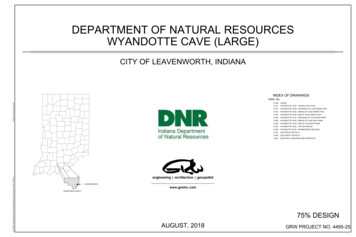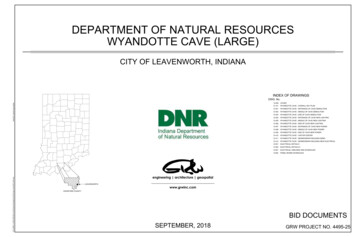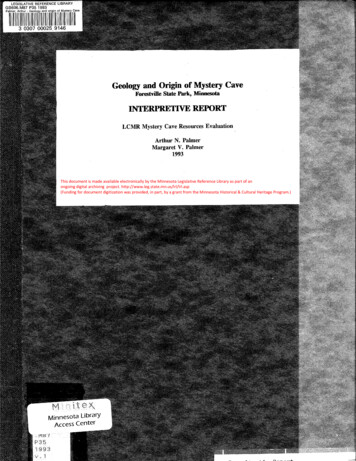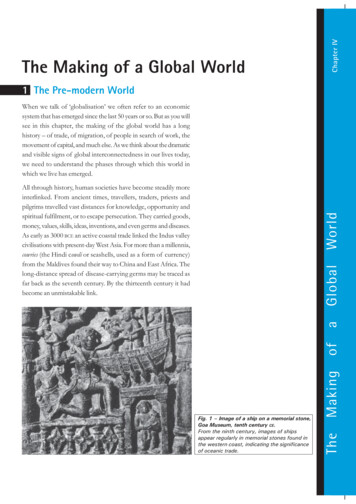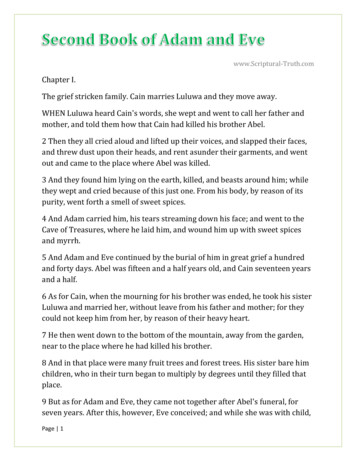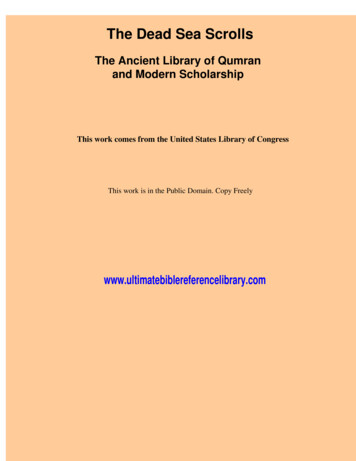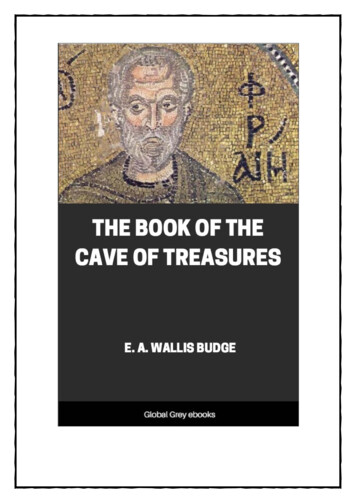
Transcription
THE BOOK OF THECAVE OF TREASURESA HISTORY OF THE PATRIARCHS AND THE KINGS, THEIR SUCCESSORSFROM THE CREATION TO THE CRUCIFIXION OF CHRISTTRANSLATED FROM THE SYRIAC TEXT OF THEBRITISH MUSEUM MS. ADD. 25875BYE. A. WALLIS BUDGE1927
The Book of the Cave of Treasures by E. A. Wallis Budge.This edition was created and published by Global Grey GlobalGrey 2018globalgreyebooks.com
CONTENTSPrefaceIntroductionTHE BOOK OF THE CAVE OF TREASURESThe First Thousand YearsThe Second Thousand YearsThe Third Thousand YearsThe Fourth Thousand YearsThe Fifth Thousand YearsThe Five Hundred Years from the Second Year of Cyrus to the Birth ofChristTestamentum AdamiSupplementary Translations From The "Book Of The Bee."Abraham And The City Of UrIllustrationsBibliography
Sumerian relief in copper on wood representing Imdugud, or Imgig, the lion-headed eagleof Ningirsu, the great god of Lagash, grasping two stags by their tails. It is probable that itwas originally placed over the door of the temple of Nin-khursag or Damgalnun at the headof the stairway leading on to the temple platform. This remarkable monument was madeabout 3100 B.C., and was discovered by Dr. H. R. Hall in 1919 at Tall al- Ubêd, a sanctuaryat "Ur of the Chaldees" in Lower Babylonia. It is now in the British Museum (No. 114308).
1PREFACETHE present volume contains a complete translation of the Syriac text ofthe compendious history of the world from the Creation to theCrucifixion of our Lord, which is commonly known as "Me ârath Gazzê,"or the "Cave of Treasures." In the Syriac title the composition of the workis attributed to Ap[h]rêm Suryâyâ, i.e. Ephrem Syrus, or Ephraim theSyrian, who was born at Nisibis (?) soon after A.D. 306 and died in 373,but it is now generally believed that the form in which we now have it isnot older than the VIth century. An edition of the Syriac text, and anArabic version of it, together with a German translation, were publishedby Bezold (Die Schatzhöhle, Munich, 1883-86), but this work is scarceand is little known in England. The German translation was made froman eclectic text constructed from at least three manuscripts, which variedin age and accuracy and general literary value. The translation given inthe following pages has been p. xii made from the best, in my opinion, ofall the known manuscripts, namely British Museum MS. Add. 25875.(See Wright, Catalogue, vol. iii, page 1064.) This MS. contains twelvecomplete works, all of which were written, in a fine Nestorian hand, bythe priest Homô, the son of the priest Daniel, a native of Al-Kôsh, a veryancient town which lies about 20 miles north of Môsul (Nineveh), in theyear of the Greeks 2020, i.e. A.D. 1709. It was written at the expense ofthe priest Joseph, the son of Hormizd, a native of Hordaphne, in thedistrict of Amediâ, for the church of the Blessed Virgin Mary in thatplace. When I read through the manuscript in 1885, whilst preparing myedition of the "Book of the Bee," I was convinced that Homô, the scribe,was a very learned man, and the marginal notes which he added to hiscopy showed that he was at once a capable and an understanding editorof Syriac texts. When the printed edition of the Syriac text of the "Cave ofTreasures" appeared in 1886, I was surprised to find that Homô's texthad not been made the foundation of the work. Whilst I was in Al-Kôshin 1890-91 collecting manuscripts for the British Museum, I found theresome of Homô's descendants, and of these one or two were professionalscribes. They possessed a few ancient Syriac manuscripts, and from oneof them I had copies made of the p. xiii "Cave of Treasures" and the"Book of the Bee." On my return to England I collated the copy of the
2former work with the British Museum Codex, and found that the textonly varied in a few minor points. There are a few mistakes in the BritishMuseum MS., and in one or two places a few words are omitted, but as awhole it contains the text of the "Cave of Treasures" in as perfect form asever we are likely to get it; and therefore I have made the translationprinted herein from it.A text of this kind might be annotated to almost any extent, but I havelimited my notes to pointing out parallels in the "Book of Jubilees," the"Book of Adam and Eve," the "Book of the Bee," and other cognateworks. These are printed within square brackets [ ] immediatelyfollowing the passages in the "Cave of Treasures" which they illustrate.In the short Bibliography which follows the translation will be found thenames of a number of books and of editions of texts which those who areinterested in the literary history of the "Cave of Treasures" will findnecessary for useful work. I have also added a translation of the"Testament of Adam," a popular apocryphal work which is based uponthe Syriac "Cave of Treasures," and upon legends derived from books of asimilar, and perhaps allied, character.The ancient tradition which asserts that the "Cave of Treasures" waswritten in the IVth century of our Era, is supported by the generalcontents of the work. These reproduce Ephraim's quaint and sometimesfanciful methods of exegesis and his hatred of the Jews, and supply manyexamples of his methods in religious argument with which we arefamiliar from his other writings. We may notice, too, his pride in theantiquity of the Syriac language. That it was written in Mesopotamia by aSyrian, there is no doubt, and if we reject Ephraim as its author, we arebound to admit that the author, or perhaps later editor, belonged to theschool of Ephraim. Whichever view be taken is immaterial. For the bookcertainly contains a mass of historical information which can only havebeen derived from pre-Christian Hebrew works, or from post-Christianchronologies and histories written in Greek. The writers of such Greekworks derived some of their information at first or second hand, fromdocuments originally written in cuneiform. Of the general historicalcharacter of the "Cave of Treasures" there is no doubt, and it is this factwhich gives it such importance for the history of the Hebrew Patriarchs,and for early Christian History, and the Christian Faith. This view wasmaintained by the eminent scholars Dillmann, Nöldeke, p. xv Sachau,
3Wright, Bezold and others during the last century, and it was firmly heldby Christians in Mesopotamia, Syria, Palestine, Egypt, Nubia andAbyssinia for the fourteen centuries preceding.On the historical facts which form the framework of the "Cave ofTreasures," the pious author, or editor, grafted a whole series of legends,many of which deserve the descriptions of "idle stories" and "vain fables"which have been applied to them by Assemânî and the older Europeantheologians. The reader having perused them will readily understandthat such legends, containing as they do garbled history facts andanachronisms, are neither accepted nor endorsed by any member of theCommittee of the Religious Tract Society or by myself. These legendswere inserted with the view of making the "Cave of Treasures" a sort ofreligious "wonder-book" which would appeal to the vivid and credulousimaginations of Christian natives in almost every country of the NearEast; and religious "wonder-books" were intended by their authors andeditors to amuse as well as to instruct. The "Cave of Treasures" possessesan apocryphal character it is true, but the support which its contents giveto the Christian Faith, and the light which the historical portions of itthrow on early Christian History, entitle it to a very high place among theapocryphal Books of the Old and p. xvi the New Testament. These factshave induced the Committee of the Religious Tract Society to order thepublication of this the first English translation of the "Cave ofTreasures."My thanks are due to the Trustees of the British Museum forpermission to publish a photographic reproduction of the cylinder ofCyrus and photographs of Ethiopic and Syriac MSS.; to Sir FrederickKenyon, K.C.B., and the late Dr. Byron Gordon for permission to copythe photographs made by Mr. C. L. Woolley, M.A., for the JointExpedition, of the objects found at "Ur of the Chaldees"; to the Art Editorof The Times for a copy of the photograph of "Abraham's Street" at Ur; toMr. C. L. Woolley for the use of his notes and descriptions of theantiquities found at Ur; to the Rev. C. H. Irwin, D.D., General Editor ofthe Religious Tract Society, for his friendly criticisms, and to Mr. H. R.Brabrook for his practical suggestions.E. A. WALLIS BUDGE
448, Bloomsbury Street,Bedford Square, London, W.C. 1.July 30, 1927.
5INTRODUCTIONTHE SOURCES OF THE "CAVE OF TREASURES" AND ITSCONTENTS.IN the centuries immediately preceding the Christian Era certainprofessional Jewish scribes composed a number of works which maywell be described as "historical romances," and which were based on thehistories of the patriarchs and others as found in the four main divisionsof the text of the Hebrew Bible. There is little doubt that most of theseworks were written either in Hebrew or in the Palestinian vernacular ofthe period. One of the oldest of such works appears to be the "Book ofJubilees" (see page 3), (also called the "Lesser Genesis" and the"Apocalypse of Moses"), which derives its name from the fact that theperiods of time described in it are Jubilees, i.e. each period containsforty-nine years. It is more or less a Commentary on the Book of Genesis.That a version of this book existed in Greek is proved by the quotationsgiven by Epiphanius, Bishop of Salamis in Cyprus (born about A.D. 320,and died in 403 or 404), in his work on "Heresies" (chapter xxxix). Theauthor claimed boldly that his work contains the revelations which weremade to Moses by the command of God by the Archangel Michael, who isfrequently described as the "Angel of the Face," The book is not whollyoriginal, for it contains narratives and traditions derived from the worksof earlier writers; and some of the legends appear to have been takenfrom early Babylonian sources. The Hebrew, or Aramean, original is lost,and the complete work is only found in Ethiopic, in which language it isknown as "Kûfâlê," or "Sections." The Ethiopic translation was madefrom Greek.Another pre-Christian work, also written by a Jew, is the "Book ofEnoch," which exists now in a more or less complete form, only in anEthiopic translation, which was made from the Greek. This work isquoted by St. Jude (vv. 14, 15), and there is little doubt that for somethree or four centuries its authority, both among the Jews and theChristians of the first and second centuries of our Era, was very great.Whether the "Book of Enoch," as made known to us by the Ethiopicversion, truly represents the original Hebrew work is fairly open to
6doubt; in fact, it seems certain that it does not. It contains a series offragments or parts of works, of somewhat similar character, which hasbeen strung together, and then added to by writers of different schools ofreligious thought at different periods. In some parts of it traces havebeen found of beliefs which are neither Jewish nor Christian. (See page5.)From time to time during the early centuries of the Christian Eraapocryphal works dealing with our Lord and His Apostles and disciplesappeared, and, though they were written by Christians, they containedmany legends and traditions which their authors borrowed from theworks of earlier Jewish and Christian writers. Such works were verypopular among the Christian communities of Egypt and Syria, for thethirst for information about our Lord and His life and works, and theadventures and successes of the Apostles in Africa, Western Asia, Indiaand other countries was very great. Side by side with this apocryphalliterature there appeared works in Egypt and Syria which dealt with OldTestament History and endeavoured to explain its difficulties. Butthough Patriarch and Bishop and Priest read the Scriptures and thecommentaries on them to the people, and instructed their congregationsorally on every possible occasion, there was much in the ancient JewishReligion, out of which many of the aspects of the Christian Religion haddeveloped, which the laity did not understand. On the one hand, theunlettered Christian folk heard the Jews denouncing Christ and Hisfollowers, and on the other, their teachers taught them that Christ was adescendant of King David and Abraham, and that the great and essentialtruths and mysteries of the Christian Religion were foreshadowed byevents which had taken place in the lives of the Jewish patriarchs.Some of the Fathers of the Church in the Vth and VIth centuries wrotesermons and dissertations on the Birth of our Lord, and His Baptism,Temptation, Passion and Death and Resurrection, and proved byquotations from the Prophets that the son of the Virgin Mary was indeedthe Messiah and the Saviour of the world. But copies of these works werenot multiplied for the use of their congregations, most of the members ofwhich were unlettered folk, and the influence of all written discourseswas much circumscribed in consequence. The great monastic institutionspossessed copies of the Old and New Testaments written in Greek andSyriac, but these were not available for study by the laity in general, and
7it is probable that only well-to-do people could afford to have copies ofthe Books of the Bible made for their private use. Thus the circumstancesof the time made it necessary that the Fathers of the Church, or some ofthe learned scribes, should compile comprehensive works on the historyof God's dealings with man as described in the Old Testament, and showthe true relationship of the Christian Religion to the Religion of theHebrew Patriarchs and to kings of Israel and Judah. There is little doubtthat many such works were written, and that their authors based theirhistories on the writings of their predecessors, and that Christian writersborrowed largely from the Hebrew "Book of Enoch" and the "Book ofJubilees," as well as the Histories and Chronicles which were then extantin Greek. Some of the latter works, i.e. those in Greek, were written bymen who had access to information which was derived from Babylonianand Assyrian histories written in cuneiform, and, thanks to the laboursof Assyriologists, the statements based on such information can, in manycases, be checked and verified. Further reference to this point will bemade later on.The oldest of the Christian works on the history of God's dealing withman from Adam to Christ is probably the "Book of Adam and Eve"(see page 9), which, in its original form, was written sometime in the Vthor VIth century of our Era; its author is unknown. As there is no doubtwhatever that the writer of the "Cave of Treasures" borrowed largelyfrom the "Book of Adam and Eve," or from the same source from whichits writer derived his information, it is necessary to give here a briefdescription of the object and contents of this work.The oldest manuscript of the "Book of Adam and Eve" known to us is inArabic and is not older than the XIth century. But many of the legendsand traditions found in it are identical in form and expression with thosefound in the "Annals" of Sa îd bin al-Batrîk, or Eutychius, Patriarch ofAlexandria (A.D. 933-939), and in the "Eight Books of Mysteries" writtenby Clement about A.D. 750, and in the "Cave of Treasures," which is nowgenerally thought to have been written, or perhaps re-edited, in the VIthcentury. The Arabic version of the "Book of Adam and Eve" contains twomain sections. The first contains a History of the Creation, which claimsto be a translation of the "Hexemeron" of Epiphanius, Bishop in Cyprus.In it are given an account of the work of the six days of Creation, theVision of Gregory concerning the Fall of Satan, a description of the Four
8Heavens, the Creation of Man, the temptation of Eve, and the expulsionof Adam and Eve from Paradise. The title, "Book of the Aksîmâris,"would lead one to suppose that the whole work was devoted to theCreation, but it is not, for the second Section contains "The History ofthe departure of Adam and Eve from Paradise, and their arrival in theCave of Treasures by the command of God."The writer of the "Book of Adam and Eve" meant the two sections toform a complete work. The first shows how Adam fell, and the secondtells us how God fulfilled the promise which He made to Adam morethan once, that after five and a half weeks, i.e. 5,500 years, He wouldsend a Redeemer into the world who would save both Adam and hisdescendants from the destruction which his sin in Paradise had incurred,The writer of the book gives the History of Adam and Eve in full, addingas he progresses in his work the various legends and traditions which hefound in the works of his predecessors. This plan he follows until hecomes to the Flood, and on to the time of Melchisedek; but, havingsettled this king in Salem, the rest of his work becomes a bald recital ofgenealogies, only rarely interspersed with explanations andgeneralizations. Whether he was a Jacobite or Nestorian there is nothingto show in his work, and it seems that he hated the Jews not because oftheir religion, but because they had crucified Christ, and had also, in hisopinion, promulgated a false genealogy of Joseph and the Virgin Mary.Of the author of the "Book of Adam and Eve" nothing is known. Somehave thought that he was a pious and orthodox Egyptian, who wrote inCoptic and derived the legends and traditions which he incorporated inhis book from documents written in Greek or Syriac or from nativeworks of the Coptic Church. Dr. W. Meyer discovered and published (inthe Abhandlungen of the Bavarian Academy, Bd. XIV, III Abth.) twoversions of the Life of Adam and Eve, one in Greek and the other inLatin. The Greek version is called the ’Αποκάλυψις ’Αδὰμ{Greek: Apokálupsis Adàm}. (Apocalypse of Adam), and the Latin"Vita Adae et Evae." Their contents differ materially, and neither versioncan be regarded as derived from the "Book of Adam and Eve" describedabove. Like the "Book of Jubilees" and the "Book of Enoch," the "Book ofAdam and Eve" exists in a complete form only in Ethiopic, where it iscalled "GADLA ADÂM WA HÊWÂN," i.e. "The Fight of Adam and Eve[against Satan]." The best known text is given in a manuscript in the
9British Museum (Oriental No. 751. See Wright, Catalogue No. cccxx,page 213), which was written in the reign of Bakâffâ, king of Abyssinia,1721-1730. lt was one of the chief authorities used by Trumpp in thepreparation of his edition of the Ethiopic text which appeared at Munichin 1880. The forms of several of the Biblical names indicate that theEthiopic translation was made from Arabic. Translations of the completebook have been made by Dillmann, Das Christliche Adambuch,Göttingen, 1853, and Malan, The Book of Adam and Eve, London, 1882.{See page 13 for an example of the Syrian text.}The discovery of the existence of the Book called the "Cave ofTreasures" we owe to Assemânî, the famous author of the Catalogues ofOriental Manuscripts in the Vatican Library, which he printedin Bibliotheca Orientalis in four thick volumes folio. In Vol. ii. page 498he describes a Syriac manuscript containing a series of apocryphalworks, and among them is one the title of which he translates by"Spelunca Thesaurorum." He read the MS. carefully and saw that itcontained the history of a period of 5,500 years, i.e. from the creation ofAdam to the birth of Christ, and that it was a historical chronicle basedupon the Scriptures. He says that fables are found in it everywhere, andespecially in that part of it which treats of the antediluvian Patriarchs,and the genealogy of Christ and His Mother. He mentions that thePatriarch Eutychius also describes a cave of treasures in which gold,frankincense, and myrrh were laid up, and refers to the"portentosa feminarum nomina," who were the ancestresses of Christ.No attempt was made to publish the Syriac text; in fact, little attentionwas paid to it until Dillmann began to study the " Book of Adam andEve" in connection with it, and then he showed inEwald's Jahrbüchern (Bd. V. 1853) that the contents of whole sections ofthe "Book of the Cave of Treasures" in Syriac and the "Book of Adam andEve" in Ethiopic were identical. And soon after this Dillmann and othersnoticed that an Arabic MS. in the Vatican (No. XXXIX; seeAssemânî, Bibl. Orient. i. page 281) contained a version of the "Cave ofTreasures," which had clearly been made from the Syriac. In 1883 Bezoldpublished a translation of the Syriac text of the "Cave of Treasures" madefrom three manuscripts (Die Schatzhöhle, Leipzig, 1883), and five yearslater published the Syriac text of it, accompanied by the text of theArabic version.
10In 1885 I was engaged in preparing an edition, of the Syriac text of the"DEBHÛRÎTHÂ," i.e. the "Bee," a "Book of Gleanings" composed by theNestorian Bishop Solomon of Basra (i.e. al-Basrah) about A.D. 1222.Whilst making the English translation of this work I found that the "Bee"contained many of the legends and traditions which appeared in the"Cave of Treasures," and to show how greatly the Nestorian BishopSolomon had borrowed from the work of the Jacobite author of the"Cave of Treasures" in the earlier part of his work, I printed severallengthy extracts from the Syriac from the fine manuscript in the BritishMuseum, together with English translations (see The Book of the Bee,the Syrian Text with an English translation, Oxford, 1886; AnecdotaOxoniensia, Semitic Series, Vol. I, Part II), and these were thought toemphasize the general importance of the "Cave of Treasures."The author of the Book which is commonly known as the "Cave ofTreasures" called his work "The Book of the order of the succession ofGenerations (or Families)," the Families being those of the Patriarchsand Kings of Israel and Judah; and his chief object was to show howChrist was descended from Adam. He did not accept the genealogicaltables which were commonly in use among his unlearned fellowChristians, because he was convinced that all the ancient tables ofgenealogies which the Jews had possessed were destroyed by fire by thecaptain of Nebuchadnezzar's army immediately after the capture ofJerusalem by the Babylonians. The Jews promptly constructed newtables of genealogies, which both Christians and Arabs regarded asfictitious. The Arabs were as deeply interested in the matter as theChristians, for they were descended from Abraham, and the genealogy ofthe descendants of Hagar and Ishmael was of the greatest importance intheir sight, and it is due to their earnest desire to possess correctgenealogical tables of their ancestors that we owe the Arabic translationsof the "Cave of Treasures." The Nubians and Egyptians were alsointerested in such matters, for the former were the descendants of Kûsh,and the latter the descendants of Mizraim, and Ham was the greatancestor of both these nations. And it is clear that Syrians, Arabs,Egyptians and Ethiopians regarded the "Cave of Treasures" as anauthoritative work on their respective pedigrees.In the title "Cave of Treasures" which was given to the "Book of theorder of the succession of Generations" there is probably a double
11allusion, namely, to the Book as the storehouse of literary treasures, andto the famous Cave in which Adam and Eve were made to dwell by Godafter their expulsion from Paradise, and which by reason of the gold, andfrankincense, and myrrh that was laid up in it, is commonly called "TheCave of Treasures" (in Syriac "Me ârath Gazzê," in Arabic "Ma ârah alKanûz," and in Ethiopic "Ba âta Mazâgebet"). Now the Syriac work,though called the "Cave of Treasures," tells us very little about the realCave, which was situated in the side of a mountain below Paradise, andnothing about the manner of life which Adam and Eve lived in it. But inthe "Book of Adam and Eve" the whole of the first main section isdevoted to the latter subject, and from this the following notes aretaken:-When Adam and Eve left Paradise they went into a strange land, andwere terrified at the stones and sand which they saw before them, andbecame like dead folk. Then God sent His Word to them, and He toldthem that after five and a half weeks, i.e. 5,500 years, He would come inthe flesh and save man. He had already made them this promise inParadise, when they stood by the tree of forbidden fruit. The Cave ofTreasures was a dark and gloomy place, and over it hung a huge rock,and when Adam and Eve entered it they were sorely troubled. God sentthe birds, and beasts, and reptiles to Adam, and ordered them to befriendly to him and his descendants, and every kind of creature came tohim except the serpent. In their grief Adam and Eve tried to drownthemselves, but an angel was sent to drag them out of the water whichflowed from the roots of the Tree of Life, and the Word restored them tolife. Whilst they were living there God taught them how to wash theirbodies, and told them what to eat and drink, and made known to themthe use of wheat, 1 and showed them how to clothe themselves with theThe Copts have a remarkable legend about the origin of wheat. According to this, our Lordcommanded the Cherubim to take John the disciple and show him the mysteries of heaven and earth.Whilst they were journeying together through the heavens, John asked his guide to tell him the historyof the wheat plant and where it was first found. The angel said that after Adam and Eve were drivenforth from Paradise they were banished to Havilah (Gen. ii. 11), "Where they suffered greatly becausethey could not eat the poor food which the country produced. The pangs of hunger vexed them sorely,and at length they cried out to God and told Him that they were starving. Our Lord, the Word, hadpity upon them, and said to His Father, "Behold, the man whom we have created in Our image andlikeness is an hungered; now, if it be Thy will, do not let him die before Thy face." In reply God said toHim, "If Thou art moved with compassion for the man whom We have created, and who hath rejectedMy commandment, go Thou and give him Thine own flesh and let him eat thereof, for it is Thou p.19 Who hast made Thyself his advocate." Then our Lord took a little piece of the flesh of His divineside, and rubbed it down into small pieces, and showed them to His Father. When God saw them Hesaid to His Son, "Wait, and I will give Thee some of My own flesh, which is invisible." Then God took a1
12skins of beasts, and other essentials of civilization. There was no night inParadise, and when the sun set and night fell on Adam his terror wasgreat; at length God told him that the night was made for the beasts andhimself to rest in, and explained to him the divisions of time, years,months, days, etc.During the period of the abode of Adam and Eve in the Cave, Satancame and tempted them fourteen times, but whenever God saw thatthey were in danger of life or limb through the devilish wiles of the EvilOne, He sent an angel to deliver them and put the Devil to flight. Adamsuffered sorely from the heat of the sun, which caused him to fall down aprecipice, and wound himself so severely that his blood flowed out of hisbody on to the ground. When God raised him up, he took stones, andbuilded an altar. And having wiped up his blood with leaves, andcollected the dust which was saturated with blood, he offered both theleaves and the dust as an offering to God, Who accepted this, Adam'sfirst offering, and sent a fire to consume it. As Adam shed his blood, anddied through his wounds--which God healed--so also did the Word shedHis blood and suffer death. Thus the blood-offering originated withAdam.When God saw that Adam was terrified by the darkness of the night,He sent Michael into Judea, and told him to bring back tablets of gold,and when they arrived God set them in the Cave to lighten the darknessof the night therein. And God sent Gabriel into Paradise tofetch incense, and Raphael to bring myrrh from the same place, andthese symbolic substances being placed in the Cave, Adam wascomforted. Because the Cave contained these precious substances, it wascalled the "Cave of Treasures." A little later God permitted figs to bebrought to Adam from Paradise, and taught Adam and Eve to cook foodon the fire which was brought to them out of the hand of the fiery angelwho stood at the entrance to Paradise holding a fiery sword in his hand.As Adam could not obtain a supply of blood to maintain the bloodportion of His own body, and made it into a grain of wheat, and He sealed the grain in the middle withthe seal wherewith He sealed the worlds of light, and then gave it to our Lord and told Him to give it toMichael, the archangel, who was to give it to Adam and teach him how to sow and reap it. Michaelfound Adam by the Jordan, who as he had eaten nothing for eight days was crying to God for food, andas soon as Adam received the grain of wheat, he ceased to cry out, and became strong, and hisdescendants have lived on wheat ever since. Water, wheat and the throne of God "are the equals of theSon of God." See Brit. Mus. MS. Oriental No. 7026, Fol. 5aff (ed. Budge, Coptic Apocrypha, p. 244).
13offering, he laid upon the altar outside the Cave an offering made ofwheat, presumably a loaf or cake baked in hot ashes, and God accepted itand sent a fire to consume it, the Holy Ghost being present. And Godsaid that He would, when He came down upon the earth, make it to beHis flesh, which was to be offered up continually upon an altar forforgiveness and mercy. And an angel took a part of the offering with apair of fire-tongs, and administered it to Adam and Eve. ThereuponAdam established the custom of offering the wheat-offering thrice in theweek, viz. on the first, fourth, and sixth days of the week.After Adam had lived two hundred and twenty-three days in the Cave,God sent His angels to tell him to take Eve to wife, and to give the goldplates in the Cave to Eve as a betrothal gift. Adam obeyed the di
limited my notes to pointing out parallels in the "Book of Jubilees," the "Book of Adam and Eve," the "Book of the Bee," and other cognate works. These are printed within square brackets [ ] immediately following the passages in the "Cave of Treasures" which they illustrate. In the short Bib
